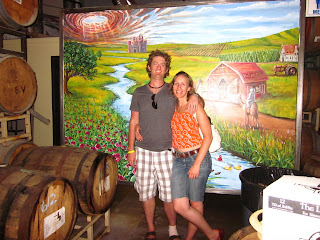Back in September of 2012, after I was told to ditch my crutches and start the road to walking "normal", Corrie and I went with Ryan and Jules to a sour beer festival in San Diego county. "It's like Skittle-brau for sure, " Ryan was telling me.
Uhhh-huuh. At the time I was a little skeptical. Here's a picture from that day. Check out the tightly wrapped bandage on my left ankle, trying to aid in support:
I remember for this picture needing to use Corrie to help me stand up straight after throwing my walking-stick cane out of frame...
Now I'm a fan, probably obnoxiously so.
But the term "sour", when used for beers, has been ambiguous and undefined at best. In general, at the base kernel, it has been used to describe beers that have a noticeable amount of acidity.
And now, as the popularity of these beers has been steadily rising, the terminology is beginning to catch up.
One of the major issues is that the spectrum of what causes acidity in beer is quite varied. Sometimes it is a wild yeast that has floated in on the wind and "ruined" an entire batch of some beer. Sometimes brewers have made a regular beer that at the last minute added a souring agent. Sometimes the beer is not a normal sour at all, but rather a fruity beer that has a touch of funk.
Normal beer descriptors and stats like final gravity (a measure of residual sweetness), color (a maltiness measure), alcohol, and IBU (bitterness measure) are used to categorize the wide varieties of beers that are coming from our country's many brewers.
Except they don't apply to sours.
And because of people's love and desire for sour beers, a new vocabulary structure has been in development so the differences between a rafter-fermented lambic and a stout that was turned in the last week of fermentation can be quantified.
The Beer Judge Certification Program has officially recognized as a label "Wild American Ales" to encompass the entire swath of styles that encompass interpretations of the Belgian tradition of brewing with wild bacteria, wild yeasts, fresh fruit, unique spices, unique barrels, and experimental technique.
"Wild American Ales" kinda doesn't do justice to the variety. But it's a start.
It is broken up into three categories: Brett Beer (named for the brettanomyces yeast strain); Mixed Fermentation Sour Ale; ans Specialty Sour Ale. Essentially: Brett, Sour, and Fruit/Spice Sour.
The march towards tasty beverages continues on unimpeded.

No comments:
Post a Comment